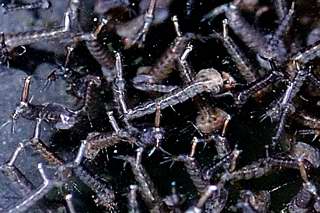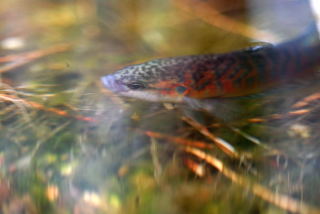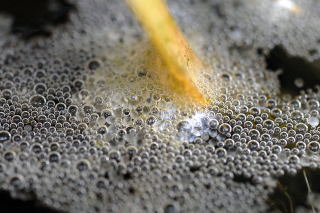Safe mosquito control measures
As with many things, prevention rather than cure is the best way to rid your garden of mosquitoes. Mosquitoes have a short life span. Approximately 10-14 days in the water as larvae and up to a month annoying us as adults. Any vessel from a pot saucer to a wheel barrow to an ornamental pond that contains water for 14 days at a stretch is a potential mosquito breeding ground.

Mosquito larvae
An easy and safe mosquito control measure is to simply store all objects that could collect water, up side down. Neglected buckets, old planters and saucers are often the worst offenders. There are of course certain things in the garden that you do wish to have water in. If you are not careful the following items can become perfect mosquito habitats:
- Water butts
- Bird baths
- Wildlife ponds
- Aquatic container gardening
Water butts
Water butts or rain collecting barrels are essential if you wish to grow carnivorous plants. Any ericaceous plants you have in pots will also prefer rain water. Mosquitoes are often able to gain access where the down pipe meets the lid. One solution is to use a piece of foam rubber. Cut a piece of foam rubber so that it will fit into the hole in the lid of your water butt. Cut a hole the foam rubber so that the down pipe fits snugly. Reassemble everything and you should have a nice well sealed water butt lid.
Alternatively if the gap between the down pipe and the lid is quite small, wrap a piece of foam rubber around the downpipe. Secure with something that wont rot such as an electrical tie and reassemble.
Bird baths
When emptied and filled regularly the bird bath does not present any problems. However during a wet summer the bird bath may remain full from rain water. As a result you may not fill it as often. In these circumstances mosquitoes can build up. So make sure you empty your bird bath regularly. This will also benefit the birds as the bird bath can become a little unhygienic.
Wildlife ponds
The main problem with the wildlife pond is that if you wish to have tadpoles you cant have fish. If you don't have fish you will have mosquitoes. Some people advocate that a wildlife pond will reach some form of equilibrium. Newts and tadpoles will eat mosquito larvae but will never keep the pond mosquito free. The idea of equilibrium is that you have a bit of everything. You don't want mosquitoes in any guise. There are a number of small 'tropical fish' that will not bother tadpoles but are a good organic mosquito control. The following fish will survive quite happily in a wildlife pond during the summer.
- White cloud mountain minnow - Tanichthys albonubes. This is a small and inexpensive shoaling fish originating from melt water rivers in southern China.
- Zebra danios - Danio rerio. Another small shoaling fish perfectly happy in the garden pond for the summer.
- Paradise fish - Macropodus opercularis. A colourful fish with the ability to breath surface air. This trait makes it particularly suitable for aquatic container garden mosquito control.
Before the onset of winter, round the fish up and keep them indoors in an unheated aquarium. These fish make a pleasant change to the usual goldfish. A good time to add them to the wildlife pond is in early spring before the mosquitoes become active. It is probably a good idea not to mention that you plan to keep these fish out doors when you purchase them. Some retailers may suddenly announce that "these fish are no longer for sale."
When bringing you fish home it is important to float the bag of fish in the pond before releasing them. This allows the temperature of the water in the bag and the pond to equalise. These fish will have been kept in heated aquaria in the shop so it is particularly important to equalise the temperatures before release.
Aquatic container gardening or swamp pots
Growing marginal plants in water filled containers is the perfect recipe for mosquitoes. With a little bit of effort this need not be a problem. In the case of aquatic marginals growing in small containers do the following. Once a week simply lift the plant out of the container. Pour the water along with any mosquito eggs and larvae on to a nearby flower bed. Replace the plant and refill the container.
With larger containers where this is impractical, push a hose pipe to the bottom of the container. This will cause the mosquito larvae to dive for cover. Allow them a few minutes to recover and return to the surface. Gradually turn the hose on so that water begins to cascade gently over the side of the container. The mosquito larvae will be carried along in the current. The mosquito larvae will not realise what danger they are in until it is too late.

Paradise fish hunting for mosquito larvae
A third safe mosquito control measure for aquatic containers is the use of fish. The best candidate is the Paradise fish - Macropodus opercularis. The fish is tolerant of a wide range of temperature. It has the ability to breath surface air and can cope perfectly in oxygen poor water. They are also extremely fond of mosquito larvae. If you plan to use these fish to control mosquito larvae it is important that the container holds plenty of water. Most important is that the size of the planting basket is sufficiently smaller than the container. The water level in the container will go down quite quickly in hot or windy weather. The fish need to be able to get to the deep water in these circumstances. Other wise they will get trapped on the surface where they will soon die. Paradise fish are not jumpers and enjoy cruising through the stems of your aquatic marginals searching for food.

Paradise fish bubble nest with eggs
The warm surface waters also provide the fish a suitable habitat for a bit of breeding. The male paradise fish builds a nest of bubbles amongst the roots and the eggs are laid and stored within. The male looks after the eggs making sure they do not fall from the nest.
The opaque bubbles in the centre are the eggs.
.
At the onset of winter, the fish should be removed and kept in an unheated aquarium indoors until the following year.
.

